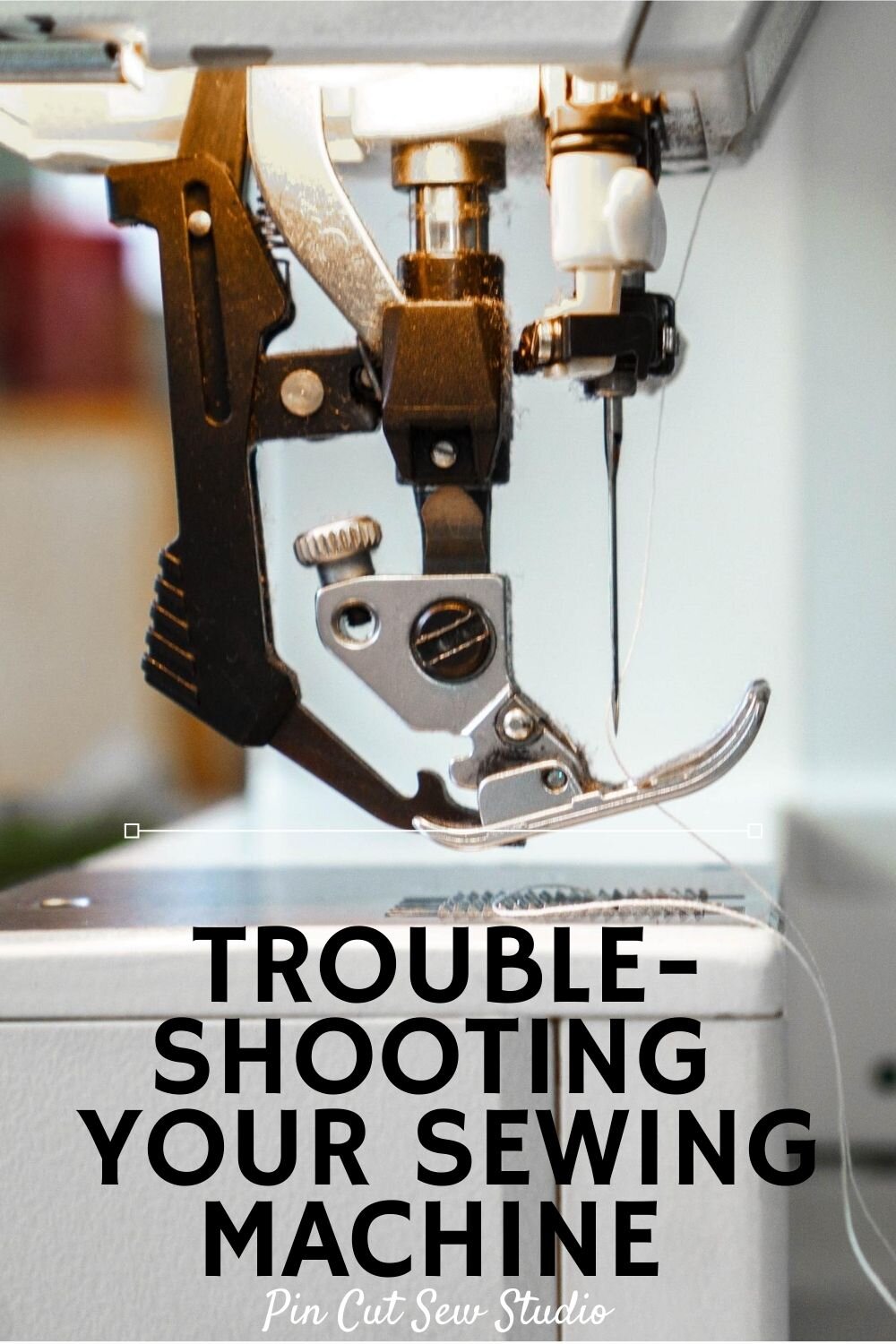Troubleshooting Your Sewing Machine
I’m a part of some fun sewing groups on Facebook and something I notice quite often is people who are newer to sewing asking questions about what’s going wrong with their sewing machine. They usually have a photo of a gnarly thread next, or skipped stitches, or the like, and they’re usually assuming they need to take their machine in to get serviced, or sometimes they even ask if they just need a new machine.
While occasionally there might be a serious timing issue or broken part that means your machine needs servicing, that’s not usually the case. As I’ve advised others about fixing their sewing machine’s problems, I’ve noted that the solution is pretty simple 90% of the time! So, I thought I’d post a list of a few things try before you take your machine to be serviced.
This post may contain affiliate links, which means that while I am not paid to promote certain items, I will earn a small commission should you purchase items through these links. For more info, see my disclosure policy.
Troubleshooting Your Sewing Machine: 7 Things to Try
First:
Stop and rethread both the top thread and the bobbin thread. Make sure the thread is in all the places it’s supposed to be! Sometimes when someone gets a knot of thread on the bottom of their work, they’re assume they have a problem with the bobbin. So they rethread the bobbin and not the top thread, when it could be that the issue caused the top thread to come out of one of its channels. So rethreading is always the first thing to try!
Second:
Change your needle. I was sewing the other day and my machine got stuck on a thicker part of my project and jammed up a little bit. When I took my seam ripper to the piece I’d been sewing to repair the issue, I realized the tiniest tip of the needle had broken off and stuck in my piece! If i hadn’t noticed, I would have kept sewing with a blunted needle, which surely would have caused more problems. Sometimes the needle can become bent too, or sometimes it’s just old. How often should you change the needle in your sewing machine? As a rule of thumb, you should change your needle before each project. This will also ensure you are using the correct needle, which brings me to my third tip …
Third:
Use the right needle for the job. If your sewing machine is skipping stitches, it’s almost always because you’re sewing a stretch (knit) fabric with the wrong needle. To sew with knits, you need a stretch needle, also called a ballpoint or jersey needle. This needle, rather than having a sharp point that punctures the fabric, has a rounded point that separates the fibers of knit fabrics to sew them. If you use a regular needle to sew knits, the needle tries to puncture the fabric, but the fibers just stretch downward with the needle, causing the skipped stitches. A walking foot is my other recommendation for sewing with knits. Other fabrics, like very lightweight ones, need smaller needles. I use a size 70 for those fabrics, like chiffon. For jeans, you need a thicker, stronger needle, like size 100, or denim needles. Fabrics with a very tight weave, like silk, need microtex sharps. I have a nice stash of needles on hand so I’m always prepared for every project. It’s the worst to have everything you need to get started except the right needle!
Fourth:
Clean out the fuzz. This should probably be right up there with number 1, but these really could go in any order, so I’ll just put it here. Use your little cleaning brush to open up the bobbin area and get all the fuzz out. If it’s been awhile, you can unscrew the throat plate and get even more fuzz out that way. While you’re doing maintenance, go ahead and oil the machine while you’re at it. I oil mine every 6 months.
Fifth:
Are you using new, all purpose thread? I had a friend gift me some vintage wooden thread spools that were her grandmother’s. Later, she began learning to sew and was having trouble with her sewing machine breaking thread. I immediately asked her what thread she was using and sure enough, she was using those old thread spools of her grandma’s! Ha! She purchased some new thread and the problem was solved. For almost all machine sewing projects, all purpose polyester thread does the trick. I use Hobby Lobby’s brand of thread or Coats & Clark, but many people swear by Guterman, a very nice brand.
Sixth:
Check your tension. One time a friend brought her sewing machine over for me to look at because she couldn’t get it to sew at all. I took one look at it and the tension was set to zero! I turned it up to 4 and it worked like a champ. The machine had been in storage and she hadn’t sewn in years, so didn’t even know to check that. Most machines, when the tension is set correctly, will never need the tension adjusted. In my experience, 4 is the magic number, as you can see on all my machines below.
If you’re using an older machine, your bobbin tension can also be adjusted. Be careful with this, though! It only takes a tiny quarter turn of the little screw to make the difference. So if you’re noticing your bottom thread is just sort of loose, or making your stitches slightly crooked, you can try tightening that little screw just a tiny bit to the right. Or if your stitches are pulling too tightly, turn it a tiny bit to the left. Once you get it right, you shouldn’t need to mess with it again. In the photo below, it’s the larger of the two screws I’m talking about.
Seventh:
Machines have quirks. Part of problem solving when sewing is simply just knowing your machine and it’s quirks. I met someone in a Facebook group that has the same vintage 60’s Pfaff as I do and hers only likes Guterman thread and it doesn’t do well with other brands, while mine does just fine. My other main machine is a Pfaff from the 90s and I’ve learned that it prefers the thread to be placed on the spool in a certain direction and has more issues when placed the other way. I know just how to tug the threads as I start sewing so my project doesn’t get stuck and I know exactly how to help my machine get over thick bumps of layered fabrics and what my machine can tolerate. These things come with experience! So just keep learning.
When to take your machine to get serviced …
There are obviously times when you’ve tried everything and your machine may need serviced. Most commonly, the machine needs a timing adjustment. But if you’re new to sewing and want to avoid paying a service fee unless you really need to, try having an experienced friend take a look first. They might see or try something you haven’t. I’ve had a couple friends send me videos of issues and it turned out to be something simple both times. But if you’ve tried all these things and asked an experienced friend and are still having issues, find a trained pro with the peace of mind that it’s money well spent!
When to replace your machine …
This may seem counterintuitive, but the worst reason to replace a sewing machine is because it’s old. Old machines are usually still really great, reliable machines! Like I said, my main sewing machines are a semi industrial from the 60’s and a computerized machine from the 90’s. Both are amazing and much nicer than anything I could afford to buy new. So if you’re using your mom’s old Juki, or Viking, Pfaff or Bernina, get that sucker out, oil it and clean it, or get it a professional tune it up if need be, but don’t think it needs replaced just because it’s old! The only time I would recommend replacing your sewing machine is if you bought a cheap beginner model and are either having constant issues with it, or have outgrown its capabilities. I’ve recently written an extensive post with tips for buying a new sewing machine with options for every budget. So if you’re thinking you need a new sewing machine, be sure and read those tips!
I hope you find this helpful in troubleshooting your machine! If you need specific help, I’d be happy to help you via email if you reach out to me :)
Cheers!
Nikki

















My best tips for teaching someone to sew.